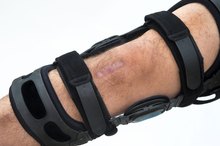What Are the Symptoms of a Failing Knee Replacement?
Knee replacement surgery can be a life-enhancing procedure for those who suffer from chronic, disabling end-stage arthritis. Quality of life can be improved immensely, and return to near-normal function and to activities of daily living are major goals of this type of surgery. Infection, implant loosening and knee cap dislocation can cause your knee replacement to fail. See your surgeon if you experience symptoms of a failing knee replacement 3.
If you are experiencing serious medical symptoms, seek emergency treatment immediately.
Pain
When prosthetic components begin to fail, issues such as fracture of the plastic spacer located between the metallic thigh bone and shin bone implants can occur from abnormal wear patterns or improper surgical techniques. Plastic fracture fragments can dislodge and become stuck between these surfaces, causing pain and mobility problems. Pain can begin as a mild soreness, or it can be severe if the fracture of the plastic occurs suddenly.
Swelling
Complications of ORIF Ankle Surgery
Learn More
Swelling occurs as a result of inflammation of the lining of the knee, which in turn stimulates production of fluid. This is the body's response to irritation, causing swelling in your knee. This irritation is frequently caused by the presence of microscopic pieces of plastic in the knee fluid, as well as the instability caused by loosening of the joint.
Instability
Instability in the knee often feels like the knee wants to give out with standing or walking. This is frequently caused by excessive wear of the plastic spacer, causing it to be thinner than it was at the time of surgery. Ligaments become loosened, making your knee joint less stable.
- Instability in the knee often feels like the knee wants to give out with standing or walking.
- This is frequently caused by excessive wear of the plastic spacer, causing it to be thinner than it was at the time of surgery.
Warmth
Most Common Side Effects After Hip Replacement Surgery
Learn More
In addition to the swelling that can occur, another symptom of a failing prosthesis can include noticeable warmth of the joint. Replaced knees can exhibit warmth in the joint for months after surgery, but this effect steadily decreases over time. The warmth associated with prosthetic failure can often be significant and associated with a level of redness of the skin caused by inflammation.
Related Articles
References
- Joint Implant Surgery & Research Foundation: Failure Mechanism on Total Knee Arthroplasty
- Arbab D, Reimann P, Brucker M, Bouillon B, Lüring C. Alignment in total knee arthroplasty - A comparison of patient-specific implants with the conventional technique. Knee. 2018;25(5):882-887. doi:10.1016/j.knee.2018.05.017
- Wang H, Foster J, Franksen N, Estes J, Rolston L. Gait analysis of patients with an off-the-shelf total knee replacement versus customized bi-compartmental knee replacement. Int Orthop. 2018;42(4):805-810. doi:10.1007/s00264-017-3622-z
- Zeller IM, Sharma A, Kurtz WB, Anderle MR, Komistek RD. Customized versus Patient-Sized Cruciate-Retaining Total Knee Arthroplasty: An In Vivo Kinematics Study Using Mobile Fluoroscopy. J Arthroplasty. 2017;32(4):1344-1350. doi:10.1016/j.arth.2016.09.034
Writer Bio
Ken Chisholm is a freelance writer who began writing in 2007 for LIVESTRONG.COM. He has experience in health care, surgery, nursing and orthopedics as an orthopedic physician assistant and a registered nurse. He holds a bachelor's degree in business from the University of Findlay, Ohio.







